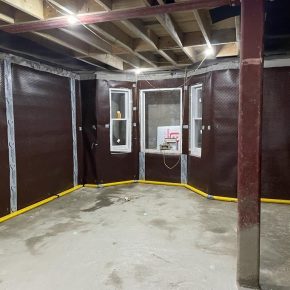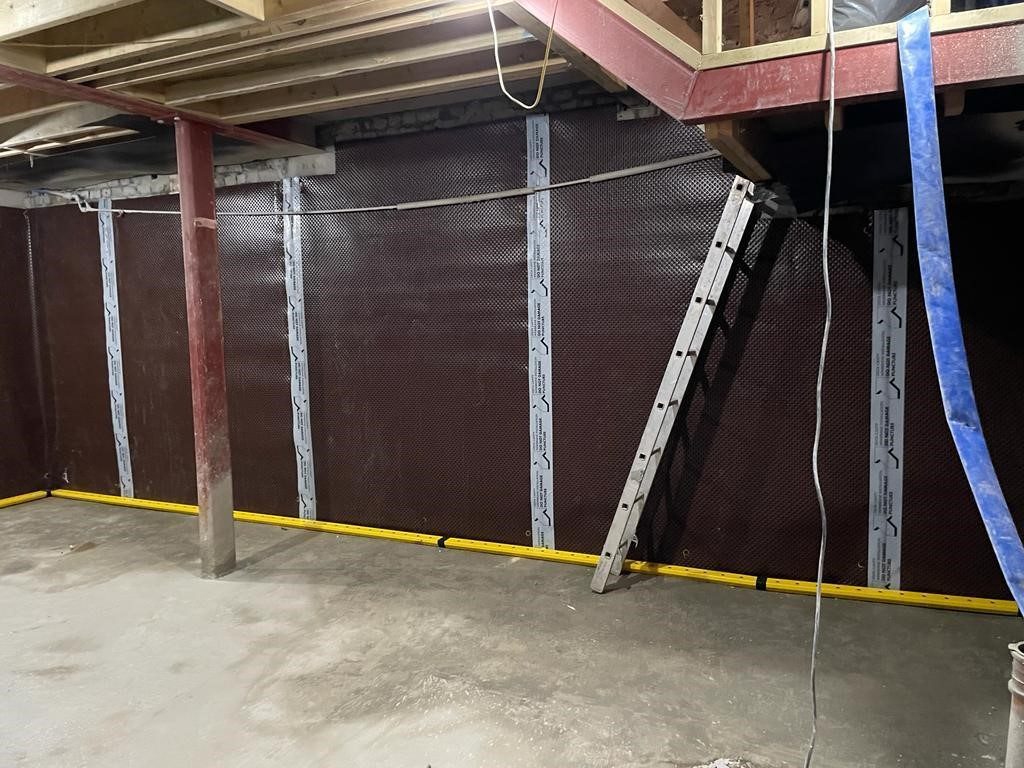
Delta: Basement Waterproofing and Ground Gas Protection
To fulfil the requirements of BS8102:2022 and BS 8485:2015+A1:2019, a strategy to develop a specification which combines structural waterproofing and ground gas protection was required for a refurbishment project that involved creating additional living space to an existing mid terrace Victorian property in W12. Step forward Delta Membranes…
The site of the property, whilst not being located on contaminated land was identified as being potentially at risk, it was near what is classed as contaminated land (an old brick yard).
To satisfy Building Control requirements gas protection measures were required to meet BS 8485:2015+A1:2019.
Site investigations at former brickworks and landfill sites are within expected UK guidelines for contamination. Ground investigations incorporate both soil sampling, ground gas and groundwater monitoring.
In accordance with Table 3 of BS 8485:2015+A1:2019 a residential building is classed as a Type A building, creating a ‘high risk’ requirement for ground gas protection. With the structure requiring a Grade 3 habitable environment attention as required to offer a system which meets all requirements.
Delta Registered Waterproofing Installers, MGA Contracts, carried out the refurbishment which initially involved lowering and reinstating the basement slab before installation of a suitable ground gas protection system and waterproofing system.

Methodology
For this project a specialist waterproofing, and ground gas protection system were required. Following initial site inspections, review of site investigation reports, structural drawings, and details along with the requirements of Building Control for gas protection measures, the client to have a dry basement a strategy was developed to address all issues.
Addressing initial water ingress issues, incorporating a combined system of ground gas protection and structural waterproofing. The structure had been constructed with limitations which would impact on the specification of approach. Both the ground gas protection system and waterproofing system required an interface which would satisfy both the known and unknown levels of ground gas. By using two forms of waterproofing, an initial (primary) and a secondary system, such as a Type C cavity drainage system.
The residential structure was also required to satisfy requirements within BS 8485:2015+A1:2019.
The project was split into two phases:
No. 1 – to stop active leaks within the primary waterproofing system and to install a primary ground gas protection system.
No. 2 – to install a secondary waterproofing system and ground gas protection system, such as the Delta Type C, AT 800 Cavity Drainage System.
Phase 1
To stop active water ingress. To facilitate the first phase of works, dewatering of the site was required.
The speed of ingress of groundwater was observed and calculated at a rate of 6-7 litres per second through a number of cracks and joints in the structural slab.
Koster 2 IN 1 was used to stop this active water. Resin Injection is a method of waterproofing designed for injecting cracks in concrete and masonry where there is a need to exclude water and water vapour from contact with reinforcement, as well as waterproofing joints and leaks. Resin injections are injected into concrete, stonework, and brickwork without leaving unsightly surface marks and offer a rapid and economical repair.
To address water seepage around pipe penetrations, the area around these were chased back to a depth of 50mm, with Koster KB Flex 200, a permanent plastic sealing compound being used.
Koster Sewer and Shaft Mortar was applied on the entire lower sections of the basement prior to 2 coats of Koster NB 1 being applied.
The Type C cavity drain system would offer a maintainable waterproofing solution in the event of future hydrostatic pressure.
Phase 2
Once the initial primary waterproofing system had been incorporated into the project and active water ceasing, further monitoring for ground gas contamination was carried out. No significant levels of ground gas were detected which would pose risk to health.
Delta drainage channel was embedded into preformed recess/gullies at the floor/wall junction with inspection and maintenance points to comply with BS 8102:2022 and a mechanical sump pump system was included in the waterproofing design.
Revisions were made to the Type C; cavity drain membrane system as initially proposed. As to using a regular Type C, HDPE membrane, the Delta AT 800 membrane was incorporated into the design. Delta AT 800 not only provides a suitable Type C drainage system but also provides an effective gas barrier in accordance with Table 7 BS 8485:2015+A1:2019 and achieves less than 40ml/m2/day/atm in accordance with ISO 150501-1 Methane permeability test (Manometric method). All joints on the membrane were double sealed. Additional ventilation was introduced to the Cavity drainage system at high level and from the sump system to external atmosphere.
Once installed, independent third-party verifiers tested the ground gas protection system to ensure characteristic scores within BS 8485:2015+A1:2019 were met.
Case Study Results
The property required a flexible waterproofing system to allow for movement whilst remaining watertight. This was achieved using Delta’s AT 800, Type C cavity drainage membrane.
With ground gas protection in combination with structural waterproofing, the most effective designs combine multiple forms of protection.
MGA Contracts Ltd has supplied the client with a dry, modern addition of living accommodation which will remain fully protected against the long-term threat of water and damp ingress and ground gas contamination and will certainly add value to the property.
Delta Membrane Systems,
Delta House,
Merlin Way,
North Weald,
Epping,
Essex,
CM16 6HR
United Kingdom
Visit Delta Membrane Systems' website
Visit Supplier's page
Latest news

28th March 2025
Ideal Heating Commercial announces 10-year warranty on Evomax 2 boiler
Evomax 2, the UK’s number one selling commercial wall-mounted boiler from Ideal Heating Commercial, is now available with a 10-year warranty.
Posted in Articles, Building Industry News, Building Products & Structures, Building Regulations & Accreditations, Building Services, Facility Management & Building Services, Heating Systems, Controls and Management, Heating, Ventilation and Air Conditioning - HVAC, Innovations & New Products, Pipes, Pipes & Fittings, Plumbing, Retrofit & Renovation, Sustainability & Energy Efficiency, Videos
28th March 2025
FLIR Si1-LD Acoustic Imaging Camera for Compressed Air Leak Detection
FLIR, a Teledyne Technologies company, introduces the Si1-LD, an industrial acoustic imaging camera that brings faster and more accurate compressed air leak detection to those operating on a modest condition monitoring budget.
Posted in Acoustics, Noise & Vibration Control, Articles, Building Industry News, Building Products & Structures, Building Services, Facility Management & Building Services, Information Technology, Innovations & New Products, Retrofit & Renovation, Sustainability & Energy Efficiency, Thermal Imaging and Monitors
28th March 2025
LIFTEX 2025 Seminar programme announced
Registration has opened for LIFTEX 2025. Now in its 37th year, LIFTEX 2025 is the UK’s only dedicated exhibition for the lift, escalator and access industry and takes place only once every three years.
Posted in Access Control & Door Entry Systems, Accessibility, Articles, Building Industry Events, Building Industry News, Building Products & Structures, Building Regulations & Accreditations, Building Services, Exhibitions and Conferences, Facility Management & Building Services, Health & Safety, Retrofit & Renovation, Security and Fire Protection, Seminars
28th March 2025
MCRMA welcomes ArcelorMittal UK to membership
A UK division of the global steelmaking business ArcelorMittal has become the latest new member of the MCRMA, the industry association representing the metal building envelope sector.
Posted in Articles, Building Associations & Institutes, Building Industry News, Building Products & Structures, Building Systems, Cladding, Facades, Posts, Restoration & Refurbishment, Retrofit & Renovation, Roofs, Steel and Structural Frames, Walls
 Sign up:
Sign up: